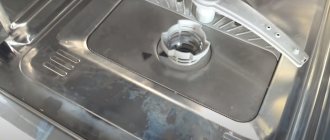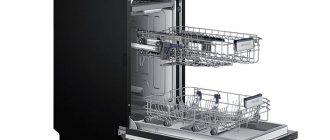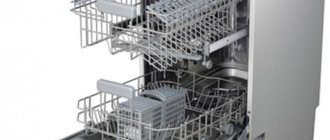Our gallery of works
Installing a built-in dishwasher in a cabinet
The dishwasher should be placed freely in the prepared niche, leaving small gaps on the sides. Taking into account all the nuances, further installation and connection of the built-in dishwasher in Moscow is carried out in the following order:
- Fitting. Includes placing the PMM in the cabinet and checking the possibility of connecting the liner;
- Assembly. Having pulled the equipment back, the fasteners, panels and vapor barrier are fixed;
- Installation. The built-in dishwasher slides back. Water supply and drainage are connected. The height of the legs is adjustable. Next, the headset is fixed to the walls;
- Facade hanging. Using the complete template, marks are made on the facade for self-tapping screws. The decorative facade is covered with double-sided adhesive tape and leaned against the equipment, aligning the mounting holes. Having combined them, tighten the fastening screws;
- Examination. After installation, the technician will check the operation of the equipment by conducting a test run of the washing mode. After making sure that there are no defects, the master delivers the order to the client.
Dimensions for built-in dishwasher
You can select the dimensions before purchasing on the website of the store or manufacturer.
They must be a multiple of the height and width of the tabletop, as well as all the parameters of a niche or cabinet if the equipment needs to be hidden behind the door. Instead of a regular door, a decorative damper is often used, designed in the same way as the entire facade. There are several standard solutions. The standard depth is 0.55 m. This leaves enough space of just under 50 cm for water supply and air cooling. For kitchen sets designed for standard apartments, narrow models with a width of 0.45 m are produced. It can vary up to 0.65 m. Most often it is 0.6 m. The height ranges from 0.815 to 0.875 m. It is a multiple of the height of ordinary countertops
There are dishwashers with minimal dimensions for installation. They are installed not only under the countertop. They are even located in the upper modules. The upper cabinets are narrower, and their depth is on average 15 cm less. In this case, problems with drainage should not arise even at a considerable distance from the siphon. You will only need to hide the drain pipe, connect the device to the water supply and resolve the electrical issue. Such devices have low productivity, but they are compact and consume less water and electricity.
Kitchen furniture manufacturers make a small margin by adding 2 mm on each side inside the modules. On the contrary, the built-in equipment is slightly smaller than the declared dimensions. This is necessary so that it fits into the niche prepared for it, even taking into account small irregularities.
The dimensions of the built-in dishwasher are one of the most important selection criteria. If it does not fit in size, it is better to refrain from purchasing and continue searching.
Weissgauff dishwasher
Where you should definitely not install a dishwasher - basic safety precautions
Not only its possible service life, but also your safety depends on the correct location of the dishwasher. When installing the machine, it is important to follow the manufacturer's recommendations. As a rule, all restrictions and prohibitions are specified in the instructions. General requirements for where the dishwasher should be:
- Away from the hob. It is prohibited to place a dishwasher under it due to excessive heat, which can damage the electronics.
- At a distance of at least 30 cm from the oven. Different manufacturers give different figures from 15 to 40 cm, but if you do not know the recommendations for your product, you can set 30 cm, this is usually enough.
- Between kitchen drawers. It is not advisable to place the headset in the outermost drawer of built-in models. It is best to place them between two adjacent cabinets or between a cabinet and a wall.
- Not close to the washing machine. When washing and spinning, the latter vibrates strongly, which is bad for any equipment. If the dishwasher is loaded with thin and fragile dishes, they may break due to shaking.
- Away from the microwave. It heats up just like an oven.
- Near the sewer, an outlet (it is better to do it specifically for it), water pipes. This will make installation easier. If the pipes are too far away, you will have to buy additional hoses, but they are not cheap. In addition, they create a danger of flooding of the lower floors if they break.
The electronics of the dishwasher can be affected by sources of increased heat and frequent vibrations. It is also important to ensure the correct position of all wires and connections, hoses for collecting and draining water. Before installation, make sure that no cables or hoses are pinched and that they are positioned at the correct angles (for example, some hoses cannot be bent more than 90 degrees). All this information is again in the instructions.
Installation procedure
Before connecting the dishwasher, you need to prepare a powerful electronic line.
Important! Find a compartment for connecting a hose with a cold water pipe. Preferably through a siphon located under the washing device.
The first stage is the installation of electrical wiring. In order to avoid emergency troubles with electricity during the operation of household appliances, it is necessary to provide safe lines in advance.
The stage includes some installation and construction work:
- gating of walls for internal wiring;
- installation of a circuit breaker;
- installation and output of wires;
- testing the socket - you can connect the cable of the household appliance.
The second stage is to connect the water supply.
A tee or manifold is installed at the connection point of the mixer. This way, water can simultaneously flow to the dishwasher and the faucet of the washing device.
Important! For household appliances, tees are specially sold to separate the water supply. Washing household items may be difficult if the water supply hose is kinked.
An adjustable device is designed for three or five household appliances. The collector will supply water to the following home appliances:
- dishwasher and washing machine;
- water heating boiler;
- filters.
The final step is the integration of the drain hose.
Connecting the drain hose
A good installation option is to connect the outlet end of the dishwasher to the siphon under the sink.
Since the water flows into the siphon, no sewer odors will enter the appliance room.
How to install a dishwasher: checking the contents and unpacking
Preparing for installation of a dishwasher includes two more stages, in addition to choosing a location: unpacking and checking the contents. It is recommended that unpacking be carried out in the presence of employees of the company from which the unit was purchased. This is necessary in order to check the presence of all parts necessary for installation. If there is a problem with the packaging, then you must inform the company’s employees about it.
Note! You also need to check the availability of instructions (necessarily in Russian). Without it, it is much more difficult to independently understand the design features of a particular model.
If necessary, you can try looking for installation instructions on the company's website. Many well-known brands add them to the product description (for example, Bosch). Dishwasher instructions are very important, so don't ignore this point.
When checking the package, you need to pay attention to the presence of instructions in Russian
In addition to the dishwasher itself, the kit often includes parts that are necessary for the correct installation of decorative trims. It is also necessary to check the presence of retaining elements, a rubber apron used for protection, and gaskets with hoses. The latter are needed when connecting the device.
Preliminary work before installation of PMM
There are two options for installing a dishwasher: yourself and with the help of specialists. In the first case, you risk connecting the car incorrectly; in the second, you will have to part with part of the family budget.
Sometimes the skills of one craftsman are not enough; you have to call a team of specialists: a furniture assembler, a plumber and an electrician.
Installation services for built-in equipment are offered by companies that sell them. For a certain fee, a universal master comes at the appointed time, carries out all the connection work and checks the serviceability of the machine.
However, if you carefully study the installation instructions, think about connecting hoses, find or install an additional outlet, you can save money and acquire new skills by doing everything yourself.
Choosing a location based on size
An important step is choosing a location for installation . For the built-in model, furniture modules of the first level are suitable, that is, cabinets standing on the floor.
But if you like a compact mini-dishwasher, then its installation is a little easier - such equipment can be inserted at waist or chest level (for ease of maintenance).
There are several conditions for choosing a good location. If they are not followed, you may later encounter problems with water supply/discharge or PMM maintenance.
Image gallery
Photo from
Built-in dishwasher next to the sink
Separate grounded socket for dishwasher
Suitable cabinet for dishwasher dimensions
Dishwasher Maintenance
Many installation difficulties arise when a dishwasher is integrated into an already installed kitchen set. You have to adjust cabinets to fit, and sometimes dismantle and remodel some of the furniture.
We recommend that you take care of the installation location before purchasing furniture. This also applies to other household appliances that require integration. Usually, the models you like are first selected, and when drawing up a sketch of the headset, their location and exact dimensions are taken into account. We have provided recommendations for choosing a built-in dishwasher in this material.
Preparation of tools and materials
Manufacturers of built-in PMMs sometimes list in the instructions what tools may be useful during the installation process. However, they expect that preliminary work has already been done.
If measures are required to lay a power line or tap into a pipe, the list of necessary items will increase.
To be on the safe side and save time, you should stock up on the following tools:
- hammer drill or powerful drill;
- adjustable wrench;
- hammer;
- a set of screwdrivers, including flat and Phillips;
- chisel;
- pliers;
- laser level;
- tape measure, square, pencil;
- screwdriver
In addition to tools, you will need connection parts. It is not recommended to use used elements - this will reduce their service life.
To install a socket, you need to buy the electrical installation product itself, a socket box for it, a three-core copper cable, and an additional automatic protective device.
There are special requirements for the socket: it must be of a “European” type, with grounding, preferably protected from moisture, fully operational, without damage
To connect water, you will need a metal tee for inserting into the water supply system, fum tape, a tap for shutting off water, rubber gaskets, clamps or ties for fastenings.
If the siphon is not provided for connecting another drain hose, then it will also have to be changed.
If the voltage in the network often fails, we recommend purchasing a stabilizer. It can be installed on several devices at once.
WHAT WORK IS INCLUDED IN THE SERVICE
The turnkey installation service for an automatic dishwasher includes the following procedures:
Water supply (at this stage, water is supplied and connected for supply to the machine, as well as checking for tightness of all connections and the absence of constant high water pressure from the water supply system of the house, a special drainage tee or a tee with an angle type tap is included in the dishwashing system on a soft hose);
Placement and alignment of the dishwasher (our craftsmen are well aware of the importance of clearly horizontal placement of this electrical device; they will ensure that there are no gaps and the correct placement of the dishwasher);
Drainage (organizing a proper and sufficient drainage for dirty, waste water, as well as sealing drain connections will prevent not only flooding or accidents with an electrical short circuit, but will also eliminate possible unpleasant odors in the kitchen).
Deciding on the location
In order for your dishwasher not only to be useful, but also comfortable, you need to choose the most harmonious place for it in the kitchen. Often, a dishwasher is installed under the countertop.
Most kitchen sets already have a design solution for placing built-in household appliances, including a dishwasher. Our plumbing specialists will be able to install a built-in dishwasher reliably, selecting special high-quality fasteners, the required size, and taking into account the specific features of your kitchen and your dishwasher.
The ideal location of the dishwasher meets the following criteria:
- easily accessible and safe location in the kitchen;
- power availability;
- accessibility of water supply and sewerage.
You can place the dishwasher in a specially designated cabinet in the kitchen wall with a designated façade that completely or partially covers the dishwasher. Or install the dishwasher outside the kitchen wall.
In any case, a necessary condition is the presence of a separate electrical outlet with a power of 2.3 kW and high-quality grounding. This is a key point for your safety, since the equipment deals with both water and electricity.
Installing a dishwasher requires thinking through the optimal communication structure: water supply and drainage into the sewer system. For proper and long-term operation of the dishwasher, proper design of this system is necessary.
Don’t forget about dishwasher safety, taking into account such nuances as the distance between the dishwasher and the hob (oven), which should be at least 40 cm to avoid overheating of the electronics and the dishwasher body. The dishwasher must be secured on both sides.
The not very convenient point, of course, is that while the dishwasher is running, the faucet will be in passive mode.
According to the recommendation of kitchen design experts, it is most comfortable to place the dishwasher near the sink and utensil drawer. But installing a dishwasher under the sink is often not practiced. But if you have absolutely no other option for placing the dishwasher other than under the sink, our specialists will do this work too. They will select and install and even move the appropriate siphon so that nothing interferes with the installation of the dishwasher and its further operation.
Of course, installing a dishwasher under the sink has certain features. In particular, you will have to choose a small-sized dishwasher model, especially in terms of height. And the installation should be carried out in such a way that in the event of any sudden breakdown, you can get to the taps and turn off the water.
Installing a dishwasher with aquastop using
We guarantee high quality work!
A dishwasher installation technician from our company has the knowledge that is necessary and mandatory to diagnose a possible manufacturing defect in the machine before starting its installation. Without fulfilling this condition, it is impossible to properly start up an electric dishwasher with the aqua-stop function.
A special feature of this service is the elimination of possible vibrations when turning on and during operation of this built-in equipment. All these issues are the responsibility of our master and are always carefully checked by him before handing over the finished work to the customer.











